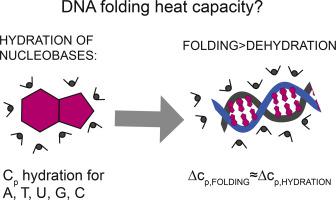Biochimica et Biophysica Acta (BBA) - General Subjects ( IF 2.8 ) Pub Date : 2020-10-23 , DOI: 10.1016/j.bbagen.2020.129774 S. Hadži , J. Lah

|
Background
Understanding DNA folding thermodynamics is crucial for prediction of DNA thermal stability. It is now well established that DNA folding is accompanied by a decrease of the heat capacity ∆cp, F, however its molecular origin is not understood. In analogy to protein folding it has been assumed that this is due to dehydration of DNA constituents, however no evidence exists to support this conclusion.
Methods
Here we analyze partial molar heat capacity of nucleic bases and nucleosides in aqueous solutions obtained from calorimetric experiments and calculate the hydration heat capacity contribution ∆cphyd.
Results
We present hydration heat capacity contributions of DNA constituents and show that they correlate with the solvent accessible surface area. The average contribution for nucleic base dehydration is +0.56 J mol−1 K−1 Å−2 and can be used to estimate the ∆cp, F contribution for DNA folding.
Conclusions
We show that dehydration is one of the major sources contributing to the observed ∆cp, F increment in DNA folding. Other possible sources contributing to the overall ∆cp, F should be significant but appear to compensate each other to high degree. The calculated ∆cphyd for duplexes and noncanonical DNA structures agree excellently with the overall experimental ∆cp, F values. By contrast, empirical parametrizations developed for proteins result in poor ∆cphyd predictions and should not be applied to DNA folding.
General significance
Heat capacity is one of the main thermodynamic quantities that strongly affects thermal stability of macromolecules. At the molecular level the heat capacity in DNA folding stems from removal of water from nucleobases.
中文翻译:

DNA折叠中热容增加的起源:水合效应
背景
了解DNA折叠热力学对于预测DNA热稳定性至关重要。现已公认,DNA折叠伴随着热容量∆c p,F的降低,但是其分子起源尚不清楚。与蛋白质折叠类似,已经假定这是由于DNA成分的脱水引起的,但是没有证据支持这一结论。
方法
在这里,我们分析了从量热实验中获得的水溶液的核酸碱基和核苷偏摩尔热容,并计算水化热容量贡献ΔC p水合。
结果
我们介绍了DNA成分的水合热容贡献,并表明它们与溶剂可及表面积有关。对于核酸碱基脱水的平均贡献是0.56摩尔Ĵ -1 ķ -1 埃-2,并且可以用来估计ΔC p,˚F用于DNA折叠贡献。
结论
我们表明,脱水是导致观察到的DNA折叠中∆c p,F增加的主要来源之一。促进了整体的其他可能的来源ΔC p,˚F应显著但似乎相互弥补,以高度。所计算出的ΔC p水合对双链体和非经典的DNA结构与整体实验良好地同意ΔC p,˚F值。相比之下,针对蛋白质开发的经验参数化会导致较差的∆ c p hyd预测,因此不应应用于DNA折叠。
一般意义
热容是强烈影响大分子热稳定性的主要热力学量之一。在分子水平上,DNA折叠中的热容量源于从核碱基中除去水。











































 京公网安备 11010802027423号
京公网安备 11010802027423号